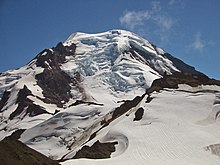
Back Ледапад BE-X-OLD Ледопад Bulgarian Ledopad BS Cascada de gel Catalan Ledopád Czech Gletscherbruch German Cascada de hielo Spanish یخشار Persian Cascade de glace (glacier) French מפל קרח HE
This article needs additional citations for verification. (September 2015) |

An icefall is a portion of certain glaciers characterized by relatively rapid flow and chaotic crevassed surface, caused in part by gravity. The term icefall is formed by analogy with the word waterfall, which is a similar phenomenon of the liquid phase but at a more spectacular speed. When ice movement of a glacier is faster than elsewhere, because the glacier bed steepens or narrows, and the flow cannot be accommodated by plastic deformation, the ice fractures, forming crevasses. Where two fractures meet, seracs (or ice towers) can be formed. When the movement of the ice slows down, the crevasses can coalesce, resulting in the surface of the glacier becoming smoother.[1]
- ^ Post, Austin; Edward R. LaChapelle (May 2000) [1971]. Glacier Ice (Revised ed.). Seattle, Washington: University of Washington Press. pp. 18–21. ISBN 0-295-97910-0.
© MMXXIII Rich X Search. We shall prevail. All rights reserved. Rich X Search